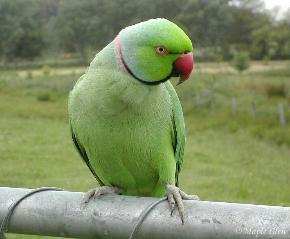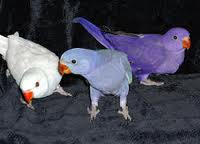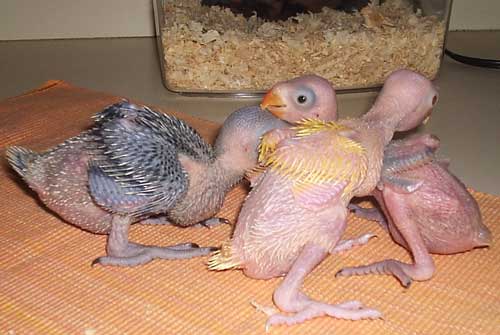
Country of Origin: India, Asia
Size: 40 cm in length from the beak to the tip of the tail.
Life span: 25-30 years
Scientific Name: Psittacula krameri manillensis
Other Names: Indian Ringneck Parakeet, Indian Ringneck Parrot, Rose-Ringed Parrot
Mutations
Description
Green, with black collar, beak band and stripe between nostrils and eyes. Red shine behind collar. Yellowish-green belly and undertail coverts, bluish-green tail feathers with yellow tips. Eyes yellow-orange, beak red, legs black. Immatures resemble adult hen, but have greenish irises and paler bills. Well-known mutations include lutino (sex-linked); blue (autosomal recessive); albino (formed from lutino and blue); cinnamon (or isabelle); grey (dominant when paired to normal). Species may have been known to Alexander the Great (356?323 BC). The related, but larger, Alexandrine Parakeet (P. eupatria) in fact bears his name. Apart from variation in size, only plumage distinction is that Alexandrines also have red shoulder patches.
Temperament
Although the Indian Ringneck has something of a reputation for being nippy and hard to tame, it is largely undeserved. Because they are so smart, Ringnecks get bored very easily, and will often resort to chewing and other destructive behavior if left to their own devices. They also go through a bluffing stage during adolescence that is difficult for some owners to manage. Ringnecks that are handled often and properly cared for, however, generally have sweet, charming personalities that make them a favorite of bird enthusiasts everywhere.
Diet
Ringneck Parakeet eat Ripening fruit, grain (will even invade grainstores, opening sacks with hooked bills and squabbling over spoils), parrot mixture, greenstuff and non-fatty seeds.
Special Needs
Generous aviary, 4 to 5 m long, because reportedly males in small areas become sterile. Young independent birds should be placed in roomy flight. Tolerates light frost, but provide temperate, protected area.
Excercise
Parakeets are very active birds, and the Ringneck is no exception. As with most other bird species, it is a good idea to have a safe area for the pet to play and stretch its wings. Ringnecks also have powerful jaw muscles to maintain, so it is wise to provide an array of chewable toys, perches, and cage accessories so that the bird is less likely to gnaw on something valuable or dangerous.
Cage Life
Ideal aviary pet, may talk well and can live for more than half a century. Possible to keep colonies. Lays 3 to 6 white eggs, incubation 22 to 26 days by female, fledging 45 to 52 days. Female starts nest inspection early in the year and will build the nest in about three days. She chews the wood shavings and chips placed in the nest box (25 X 25 X 40 cm, entrance diameter 8 cm into shape). Male feeds both female and chicks; hen helps feed after a week.




























